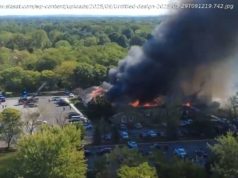In decades past, police officers who shot suspects as they ran away were more likely to expect praise than criminal charges. And while the legal landscape and public opinion have shifted in recent years, it’s never a certainty that such shootings will result in officer indictments.
CHICAGO — In decades past, police officers who shot suspects as they ran away were more likely to expect praise than criminal charges. And while the legal landscape and public opinion have shifted in recent years, it’s never a certainty that such shootings will result in officer indictments.
Prosecutors moved quickly to charge a white officer with criminal homicide Wednesday in last week’s death of an unarmed black teenager who was shot in the back while fleeing a traffic stop near Pittsburg. In two other fatal police shootings — on Monday in Galveston, Texas, and on Saturday in Minneapolis — it remains to be seen whether charges will come. Both those shootings also involved people who were running away.
A look at some of the history and legal principles of such cases:
___
OLD LAWS AUTHORIZED SHOOTINGS
The Allegheny County district attorney was direct when he announced charges against East Pittsburgh officer Michael Rosfeld.
«You do not shoot someone in the back if they are not a threat to you,» Stephen Zappala told reporters.
But in the 1970s, officers were often authorized under state law to shoot a person in the back to keep the suspect from evading arrest even if the individual clearly posed no threat. The killing of Edward Garner in 1974 changed that.
Memphis police officer Elton Hymon was responding to a report of a prowler one night that year when he saw the 15-year-old sprint across the backyard of a home that had just been broken into.
The officer later told investigators that he was quite sure Garner wasn’t armed. But on grounds that Garner was about to elude capture, he shouted, «Police! Halt!» And as the burglary suspect hopped a fence, the officer opened fire, striking Garner in the back of the head. The shooting was deemed justified.
___
LEGAL THINKING EVOLVES
After winding through lower courts for a decade, Garner’s case eventually led to a landmark decision by the Supreme Court in 1985.
The justices ruled 6-3 that shooting fleeing suspects who were not an imminent threat violated the person’s constitutional rights. They said officers can use lethal force to stop a fleeing felon only if they have reasonable grounds to think the suspect is a threat to police or bystanders. And they added that officers should, if possible, shout out a warning before firing.
Prosecutors in the East Pittsburgh case did not believe Rosfeld had reasonable grounds to consider 17-year-old Antwon Rose Jr. a threat. The teen was a passenger in a car that was suspected of involvement in a drive-by shooting. Witnesses say Rose put out his hand to emphasize to the officer that he did not have a gun before jumping out of the car and running away.
___
AN OFFICER’S STATE OF MIND
A key issue in police shootings is the officer’s sense of fear, which is rarely easy to assess.
Among the Supreme Court cases that offered some guidance was Graham v. Connor in 1989. It stemmed from the arrest of a diabetic, Dethorne Graham, who was falsely accused of stealing from a store in Charlotte, North Carolina. Police mistook Graham’s sugar reaction for drunkenness. They manhandled him and pushed him handcuffed into a police car, breaking his leg and causing other injuries.
Graham sued. The high court said the officer’s fear in the heat of the moment, not just the actual threat, was relevant. Officers, the majority opinion said, «are often forced to make split-second judgments.» And the justices concluded that the reasonableness of an officer’s use of force should be judged «from the perspective of a reasonable officer on the scene, rather than with the 20/20 vision of hindsight.»
The need to somehow demonstrate what was inside an officer’s head when he fired and to prove that an officer committed a crime beyond a reasonable doubt leaves little hope that an officer will get charged, said Chicago-based personal-injury attorney Andrew M. Stroth. He said he often tells that to families he represents. And even if an officer is charged, he braces them for difficulty of obtaining a conviction.
«There’s also just an inherent bias in favor of police by prosecutors,» Stroth said.
___
STATES MAKE OWN JUDGMENTS
Each state fashions its own laws spelling out when officers can use deadly force. There is no federal lethal-force law. The Supreme Court has helped guide many states in development of their laws, but states still have tremendous leeway over what types of standards to adopt, or whether to adopt them at all.
A 2015 Amnesty International report on the use of lethal force by U. S. law enforcement found that nine states had no lethal-force laws and that more than a dozen had laws so weak they fell short of Supreme Court standards. Prosecutors in many of those states ended up relying heavily on use-of-force procedures drawn up by police departments to help them assess if officers could be charged criminally, the report said.
Many international human-rights organizations have long urged countries, states and municipalities to craft use-of-force laws with a clear, stark provision that police should use lethal force «only as an absolute last resort.»
No state in the U. S. has a use-of-force law with such wording, according to the report.
Even when officers are charged, convictions are rare. Officers were acquitted in the 2016 shootings of Philando Castile in Minnesota and Terence Crutcher in Tulsa, Oklahoma. In Cincinnati, two juries failed to reach a verdict in the case of a University of Cincinnati officer who was tried twice for murder after killing Samuel DuBose in 2015.






